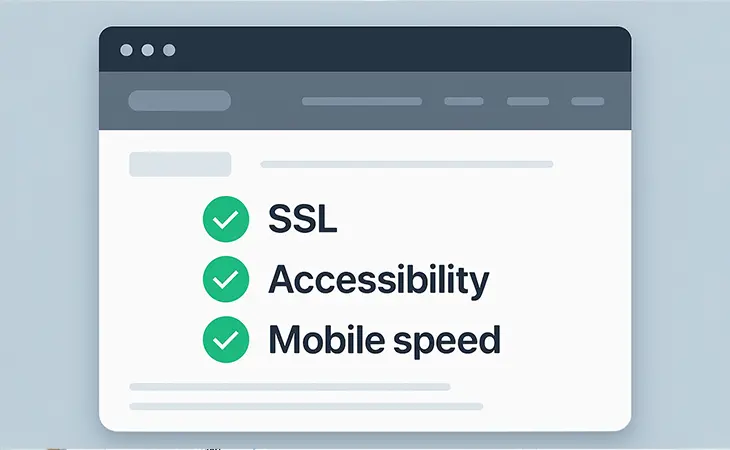SSL accessibility and mobile performance for SEO aren’t optional anymore. In 2025, they’re core ranking signals, and if your site is missing even one, it’s going to cost you in search and in customer trust.
These aren’t just technical issues your developer should “handle.” Google’s watching. Your users are noticing. And if your site loads slowly, isn’t secure, or can’t be used by everyone, they’re gone, and so is your revenue.
This post breaks down why SSL accessibility and mobile performance for SEO matter, what they impact, and what small business owners can do to get it right.
SSL (Secure Sockets Layer)
What It Is: SSL encrypts data between your website and the user. You know it’s working if your URL starts with https://.
Why It Matters for SEO:
Google publicly confirmed SSL is a ranking factor, back in 2014. In GA4, you’ll also notice insecure URLs impact behavior metrics, especially bounce rate and session duration.
Why It Matters for Trust:
Users are warned if your site isn’t secure. Literally. Chrome throws up a red “Not Secure” label. That’s enough to kill a lead before they even see your homepage.
What to Do:
- Make sure your SSL certificate is active and auto-renewing
- Use a CDN that supports SSL
- Force HTTPS across all versions of your site using .htaccess or server-side rules
This is foundational. SSL accessibility and mobile performance for SEO starts here.
2: Accessibility (ADA & WCAG Compliance)
What It Is:
Website accessibility ensures people with disabilities can use your site. That includes alt text for images, keyboard navigation, ARIA roles, and readable color contrast.
Why It Matters for SEO:
Google interprets accessible structure as “clean markup.” That improves crawlability and gives context to elements (like navigation, buttons, and image content).
Why It Matters for Trust:
Accessibility compliance builds trust—especially with organizations, institutions, and municipalities. It also reduces legal risk.
What to Do:
Add descriptive
alttext to all imagesUse semantic HTML:
<header>,<main>,<nav>,<footer>Ensure forms are labeled and accessible via keyboard
Use an accessibility checker like WAVE or Axe
If you’re serious about SEO, this is part of the work. Period. SSL accessibility and mobile performance for SEO go hand-in-hand.
Mobile Performance
What It Is:
This covers page load time, responsiveness, tap targets, font sizes, and layout shifts – especially on mobile devices.
Why It Matters for SEO:
Since Google’s mobile-first indexing, your site’s mobile performance is your performance. A slow or broken mobile experience tanks rankings, period.
Why It Matters for Trust:
Users judge you by your mobile experience. 57% of users won’t recommend a business with a poor mobile site. And if your menu overlaps content or takes forever to load, your brand looks amateur.
What to Do:
Run your site through Google PageSpeed Insights (mobile tab)
Compress images using WebP
Use
minifiedCSS & JSEnable lazy loading
Remove unused plugins and fonts
Consider switching to a lightweight theme or custom framework
Want proof? Check your engagement rate in GA4 segmented by device. If mobile numbers look weak, this is the culprit.
4: How These Three Impact Rankings Together
When we talk about SSL accessibility and mobile performance for SEO, we’re talking about trust and usability signals. They’re baked into:
Core Web Vitals
Page Experience Score
Crawl prioritization
UX-based ranking signals (engagement, dwell time, CTR)
These factors don’t just move rankings, they shape how Google interprets your value as a result.
A secure, accessible, and fast mobile site makes you look legitimate. A slow, insecure, janky one? That’s how Google treats you too.
5: The Cumulative Trust Factor
This part isn’t algorithmic, it’s human.
You’re asking visitors to give you money. They want to feel like they’re in safe hands.
If their first impression is:
“Not Secure” in the URL bar
Can’t read text on their phone
Can’t complete your form with a screen reader
…then trust is broken before you ever get a chance to sell.
SSL accessibility and mobile performance for SEO aren’t just checkboxes, they’re your first layer of credibility.
Final Thoughts
Too many businesses treat SSL accessibility and mobile performance for SEO like afterthoughts. But if you want to rank – and be trusted – it’s the foundation.
Fix your SSL first. Audit your site for accessibility. Clean up mobile performance. Then track your engagement rate, conversions, and Core Web Vitals over the next 30 days.
If the numbers don’t improve, you’ll be the first.
Further Reading
Want to explore more about SSL accessibility and mobile performance for SEO? These resources offer detailed technical breakdowns and up-to-date insights:
- Google Search Central – Page Experience Signals and SEO
- Web.dev (Google) – Core Web Vitals for Site Performance
- W3C Web Accessibility Initiative – Introduction to Web Accessibility
- SSL.com – Why You Need an SSL Certificate
Ready to Fix Your Website for Good?
Let's Grow Your Business Online
From websites to automation, we’ve helped 100+ business owners grow online




